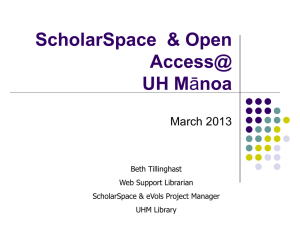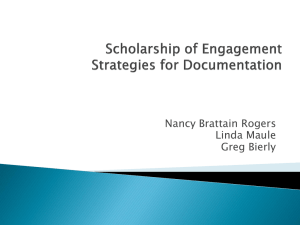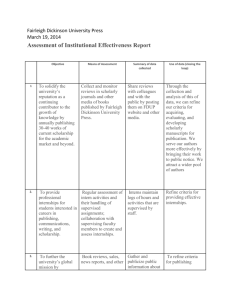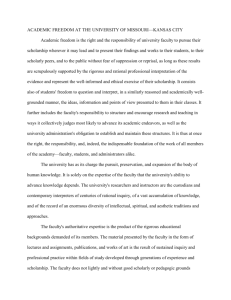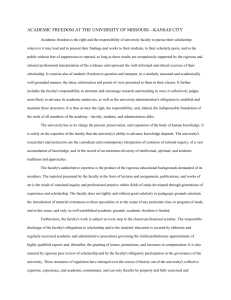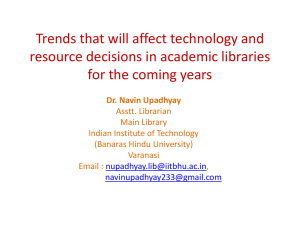DSpace
advertisement
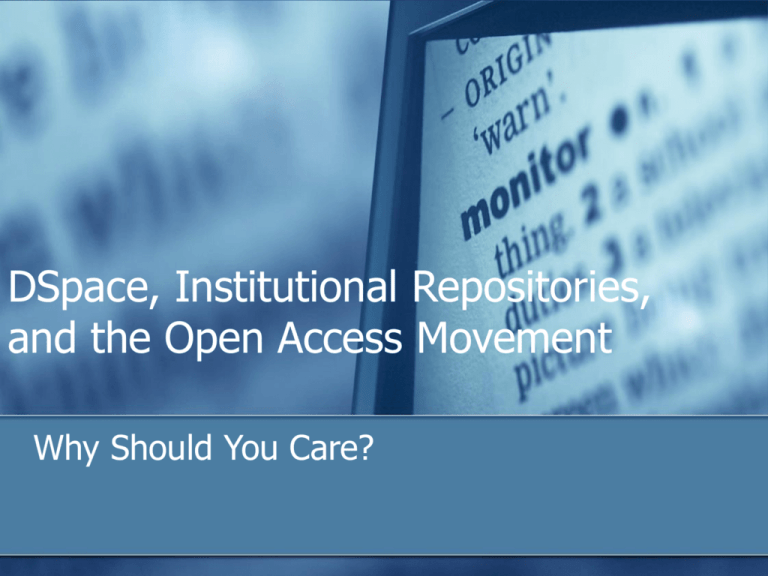
DSpace, Institutional Repositories, and the Open Access Movement Why Should You Care? A Scholarly Revolution? Luther, Judy. Tectonic Shifts in Scholarly Publishing. The Charleston Advisor, April 2005. A Scholarly Revolution? Dotlinga, Randy. Open-Access Journals Flourish. Wired News, April 11, 2005. A Scholarly Revolution? Steinbrook, Robert. Public Access to NIHFunded Research. New England Journal of Medicine, April 28, 2005. A Scholarly Revolution? Oxford Journals Launches Oxford Open - A New Open Access Initiative. Medical News Today, 05 May 2005. A Scholarly Revolution? Vogel, Gretchen and Martin Enserink. Europe Steps Into the Open With Plans for Electronic Archives. Science Magazine, 29 April 2005. A Scholarly Revolution? Wray, Richard. Britain a leader in making research available on web. The Guardian, May 17, 2005. A Scholarly Revolution? Cockerill, Matthew. Access all articles: The momentum towards free online publication of scientific research is becoming unstoppable. Guardian Unlimited, June 2, 2005 A Scholarly Revolution? Creative Commons and Science Commons Announce Open Access Law Program. Creative Commons, June 6, 2005 Road Map for the Next Half Hour A tour of UNMSOL’s DSpace Overview of the IR/Open Access movement An open access institutional repository The story behind the headlines Overview of IR options for law schools Open source license (DSpace, Eprints, etc.) Proprietary products (LSN, BePress) Implications of IR/Open Access for legal scholarship About DSpace Short for Digital Space Institutional Repository Collecting Archiving & Preserving Indexing Distributing Contents accessible to all No royalties, no subscription fee About DSpace All digital formats can be loaded Loading creates a permanent URL Decentralized submission process Creators load their own files and add indexing terms Email alerts of new submissions possible About DSpace Jointly developed by MIT & HP Labs MIT determined that it was in the best interest for the advancement of knowledge to give away course materials Vision was for scalable archive that would lead to a federated repository Release first occurred in 2002 Open source licensing DSpace DSpace Federation emerged http://www.dspace.org 2004 Google Scholar began indexing Today at least 75 institutions are using http://wiki.dspace.org/DspaceInstances DSpace Creative uses of DSpace Hong Kong http://repository.ust.hk/dspace/ Toronto https://tspace.library.utoronto.ca/ UNM & DSpace DSpace UNM became available to UNM colleges and departments on March 3, 2005 Developed by UNM ECE Turned over to UNM University Libraries for policy development Server currently housed at UNM CIRT UNM School of Law & DSpace UNMSOL DSpace established quickly Use to date: Primarily as an archive Public domain only so far Repository of faculty scholarship encouraged Administration support Access DSpace from Law Library Web page Browse casually Create login to submit files Open Access Movement Open Access Free access to scholarly communications no royalties or subscription fees Vocabulary in flux Open Articles published only in open access online journals Open access publishing access archiving pre- and post-print archiving of articles that are published in traditional manner (if license permits) Open Access Movement Traditional commercial publishing model (both print and online) Author relinquishes some control over content in exchange for convenience & services Dissemination Journals as repositories Registering intellectual property & preservation for future Certification (peer review) The Story Behind the Headlines Dissatisfaction with traditional publishing model grows Library subscription costs increasing faster than inflation Commercial interests profit from free labor of scholars and their institutions Did university tenure requirements create commercial publishing monster ? The Story Behind the Headlines Growing belief that scholarship, especially publicly funded scholarship, should not be locked up in expensive or inaccessible journals Realization that Internet makes it affordable to self publish Scholarly Communication as Profit Center Educational institutions pay steep subscription prices to access research published in commercial journals Research largely supported by taxpayers becomes source of commercial profit Elsevier’s annual profit margin—30% Elsevier’s annual revenue--$1.6 billion Median Library Journal Expenditures Slide courtesy of Dr. Daniel Greenstein, Associate Vice Provost, Scholarly Information and University Librarian, California Digital Library, University of California Subscription Costs Outpace CPI Source: Bear Stearns European Equity Research report on Reed Elsevier. September 29, 2003; slide courtesy of Dr. Daniel Greenstein Few Disciplines Are Unaffected Average Cost Per Title Average Cost Per Title Anthropology 1999 259.21 2003 353.44 Chemistry 1,682.94 2,403.06 42.79 Education 207.79 305.73 47.13 Engineering 981.19 1,359.52 38.56 Philosophy & Religion Political Science 123.27 169.89 37.82 208.07 315.00 51.39 LC Subject Classification Percentage of Increase 1999-2003 36.35 Source: Van Orsdel & Born, Library Journal, April 15, 2003; slide courtesy of Dr. Daniel Greenstein Monograph-Dependent Disciplines Also Suffer Source: Bear Stearns European Equity Research report on Reed Elsevier. September 29, 2003; slide courtesy of Dr. Daniel Greenstein Open Access Movement Libraries & STM* communities join forces and urge open revolt (2001-date) SPARC--Scholarly Publishing and Academic Resources Coalition—sponsored by Association of Research Libraries (www.arl.org/sparc) Open Access newsletter http://www.earlham.edu/~peters/fos/index.htm Open Access Blog http://www.earlham.edu/~peters/fos/fosblog.html *Commercial publishers occupy 68% of STM journal market (Industry Trends, Size and Players in the STM Market. Outsell, Inc., Aug. 2000). Open Access Movement Europe in the vanguard Budapest Open Access Initiative Dec. ’01 Convened by Open Society Institute (OSI) www.soros.org/openaccess/ 30,000 signatories, but no enabling mechanisms Berlin Declaration Oct. ’03 www.zim.mpg.de/openaccess- berlin/berlindeclaration.html Combined science & humanities; signatories agreed on open archive principles and committed to enabling them at home Started Registry of Institutional OA Self-Archiving Policies Open Access Movement Creative Commons provides copyright guidance for open access http://creativecommons.org Public interest groups get involved Alliance for Taxpayer Access http://www.taxpayeraccess.org/ Open Access Movement Other disciplines become interested Universities take action in support http://www.earlham.edu/~peters/fos/lists.htm# actions University of Kansas & Case Western Kansas was first US university to adopt universitywide open access, self-archiving policy www.eprints.org/signup/fulllist.php But What About Peer Review? Role of academic societies Vetting & publishing costs money Science Magazine editors spend $10 million a year selecting 800 articles from 12,000 submissions (WSJ) Alternative Models Emerging PLoS charges authors $1500 to submit to peer reviewed open access journals www.plos.org Open Access Movement SPARC’s Directory of Open Access Journals (DOAJ) (1,400 are peer reviewed) http://www.doaj.org Approximately 10% of journals world-wide are now some form of open access Open Access Movement Various permutations of open access publications exist E-print archives (authors submit pre- & post-prints) Unqualified (immediate and full open access) Dual mode (print together with online open access) Delayed open access (following embargo period) Partial open access Abstract open access Co-op model (institutional support for authors) Impact of Open Access on Research One study showed that 85% of the most highly cited computer science articles in 1997-98 were open access; articles with lower citations were more likely to be restricted access. Lawrence, Steve. Online or Invisible? Nature 411:6837, 521, 2001 <http://citeseer.ist.psu.edu/online-nature01/> Impact of Open Access on Research Open access has greater impact on research than traditional scholarship as demonstrated by four-discipline citation analysis using ISI Web of Science database. Antelman, Kristin. Do Open-Access Articles Have a Greater Research Impact? ELIS, 372-382, Sept. 2004 <http://eprints.rclis.org/archive/00002309/> Open Access & Legal Scholarship Legal community somewhat late to the table (with notable exceptions—Harvard, Cornell, Duke) Decentralized, law school-subsidized publishing model not subject to same inflationary pressures 2003 average price for non-commercial law journal $34.04* 2003 average price for commercial law journal $215* * AALL Price Index for Legal Publications Open Access & Legal Scholarship Growing awareness of issues Creative Commons’ Open Access Law Project, June ‘05 Dan Hunter blog on open access & law reviews, Apr. ’05 http://www.openaccesslaw.org/ AALL Task Force report on Open Access, Apr. ‘05 http://science.creativecommons.org/literature/oalaw http://www.aallnet.org/products/pub_sp0504/pub_sp0504_MB. pdf AALS meeting discussion, Jan. ‘05 Hunter, Dan publishes Walled Gardens, SSRN, Dec. ‘04 http://papers.ssrn.com/sol3/papers.cfm?abstract_id=635141 Open Access & Legal Scholarship Growing awareness that journal publication agreements might erode author rights, especially pre- and post-print rights, or grant publishers rights that were never intended? Amazon.com, in agreement with Thomson Gale Publishing, now selling full text law review articles for $5.95 Probably under Gale’s LegalTrac license Open Access & Legal Scholarship Resources to help with author agreements and law review policy formulation SPARC http://www.arl.org/sparc/author/addendum.html AALS http://www.aals.org/98-24.html Creative Commons’ Open Access Law Project http://science.creativecommons.org/literature/oalaw Institutional Repositories Part if the infrastructure of the Open Access movement Repository of an institution’s scholarship Archive, preserve, index & distribute Not merely faculty eprints, but student work, course materials, data collected by faculty during the course of their work, other “gray literature” Facilitate use and reuse of materials IR Options for Law Schools Open Source IR Options DSpace Eprints Proprietary IR Options SSRN’s Legal Scholarship Network Berkeley Press’ bepress.com EPrints Eprints is another common open source option Registry of IRs (both Eprints & DSpace) http://www.eprints.org/ http://archives.eprints.org/ Duke Law Faculty Repository http://eprints.law.duke.edu/ Proprietary IRs for Law Schools Proprietary Options SSRN’s Legal Scholarship Network (LSN) Berkeley Press (BePress) Value added by publishers make loading simple for novice Automatically converts word processed files to secured PDFs Format limitations exist Basically archives only word processed files LSN http://www.ssrn.com/lsn/ Open access archive of subject-based journals Fee-based institutional sponsorship Faculty at institutions with site licenses are free to submit pre- and post-prints as publication agreements permit (UNMSOL has site license) Means to create an open access archive for subscribing institutions Indexed by Google BePress law.bepress.com/repository/ Open access archive of subject-based and peer-reviewed journals Fee-based institutional sponsorship Indexed by CILP subject headings Means to create an open access archive for subscribing institutions Indexed by Google BePress IR Software BePress also licenses its IR and peer-review journal software Repositories using BePress software University of California http://repositories.cdlib.org/escholarship/ NELLCO repositories http://lsr.nellco.org Digital Commons repositories http://www.umi.com/proquest/digitalcommons/ Current Landscape Many versions of IRs now in play Various surveys indicate small but growing awareness about open access options Growing awareness that open access results in greater readership and impact for work deposited in open access archives Implications for Legal Scholarship IRs make it feasible for true open access to legal scholarly communication Open Access to scholarship is consistent with legal community culture and tradition Peer review of works in progress may be more feasible online than with print What will be impact on print law reviews as we know them today? Implications for UNMSOL Open Access Law Program (Hunter, Lessig, et al.) wrote to all law reviews this summer to encourage them to adopt an open access archiving policy Open access archiving permits post-print archiving of articles traditionally published Least restrictive licensing possible, e.g., Creative Common’s Model Agreement Should UNM’s law journals go on record as supporting adopting such a policy Should UNMSOL recommend a specific model license for faculty to use in publishing negotiations Implications for Legal Scholarship Could use of proprietary IRs lead to legal scholarship becoming concentrated in a small number of commercial publishers (LSN, BePress and their online journal partners) at a time when other disciplines are moving toward decentralization? 4th Annual UNM Scholarly Communications Symposium “The Digital Academy: Innovations in Scholarly Publishing” Keynote Speaker Ann Wolpert, MIT, will discuss innovative ways in which scholars are using technology to disseminate their work November 1, 2005 from 1-4 pm SUB Ballroom C Program found at: http://hsc.unm.edu/library/sc/symposium.shtml

